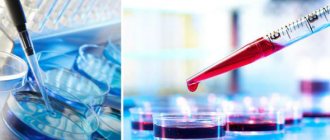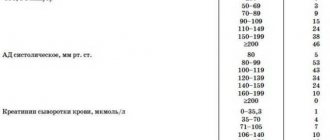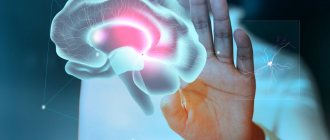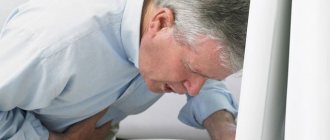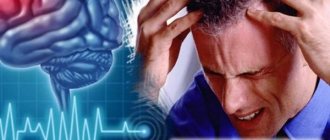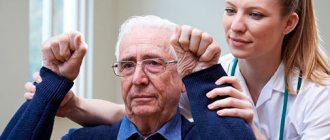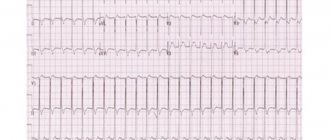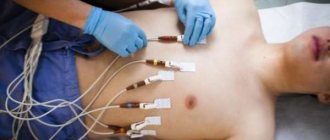From this article you will learn: what first aid should be for a stroke. Features of emergency measures at home and on the street, depending on the type of stroke.
First aid measures for stroke are a set of actions and measures aimed not only at saving the patient’s life. The possibility of restoring damaged brain cells and the functional abilities of the nervous system depends on the time and correctness of its provision. According to foreign and domestic experts, the optimal time for delivering a patient to a medical facility is 3 hours from the moment of illness (the sooner the better).
What should be done first when a person has a stroke?
Advertising:
Wherever the stroke occurs and no matter what the stroke is, both the patient himself (if his condition allows) and those around him must act according to a clear algorithm:
- Do not panic!!!
- Assess the patient’s general condition: consciousness, breathing, heartbeat, blood pressure.
- Identify the obvious signs of a stroke: unilateral paralysis of an arm and leg, a distorted face, speech impairment, lack of consciousness, convulsions.
- Call an ambulance by calling 103!
- Find out the circumstances of the illness (briefly if possible).
- Provide resuscitation measures (artificial respiration, cardiac massage), but only if they are necessary (lack of breathing, heartbeat and dilated pupils).
- Position the patient correctly - on his back or side, either with his head and torso slightly elevated, or strictly horizontally.
- Provide conditions for good oxygen access to the lungs and blood circulation throughout the body.
- Monitor the patient's condition.
- Arrange transportation to the nearest hospital.
The emergency care described above is general and does not include some situations that are possible during a stroke. The sequence of events does not always have to be strictly the same as in the given algorithm. In case of critical impairment of the patient's condition, one has to act very quickly, performing several actions simultaneously. Therefore, if possible, 2-3 people should be involved in providing assistance. In any case, following the algorithm, you can save the patient’s life and improve the prognosis for recovery.
Stages of medical care for stroke
The main principle of managing patients with acute stroke is the staged organization of medical care.
The following stages are distinguished:
I. Diagnosis of stroke and emergency measures at the prehospital stage.
II. The earliest possible hospitalization of all patients with stroke.
III. Diagnosis of the nature of the stroke.
IV. Clarification of the pathogenetic subtype of stroke.
V. Selection of optimal treatment tactics.
VI. Rehabilitation and measures for secondary prevention of stroke.
Stages of medical care for acute stroke and the goals of its provision:
1. Prehospital
(doctor, family or local doctor, ambulance or FAP paramedic)
- Diagnosis of stroke
- Carrying out emergency treatment measures
- Hospitalization
Diagnostics:
History (presence of cerebrovascular pathology, high blood pressure and other risk factors). Acute development of neurological symptoms (weakness in the limbs, impaired speech, breathing, consciousness, facial asymmetry, etc.).
The main task at the prehospital stage is the correct and rapid diagnosis of stroke as such. An exact determination of the nature of the stroke (hemorrhagic or ischemic) is not required; it is only possible in a hospital after CT or MRI studies of the brain. The clinical picture of the development of stroke is characterized, as a rule, by the sudden (within minutes, less often hours) appearance of focal (or cerebral, and in the case of subarachnoid hemorrhage (SAH) - meningeal symptoms.
For correct and timely diagnosis of stroke, it is necessary to know the focal, cerebral and meningeal symptoms characteristic of this disease.
Detailed description of all emergency steps
Each activity that includes first aid for a stroke requires proper execution. It is very important to adhere to subtleties, since any “little detail” can be fatal.
No fuss
No matter how serious the patient’s condition, do not panic or fuss. You must act quickly, harmoniously and consistently. Fear, fuss, haste, and unnecessary movements lengthen the time it takes to provide assistance.
Reassure the patient
Every conscious person with a stroke is definitely worried. After all, this disease is sudden, so the body’s stress reaction cannot be avoided. Anxiety will aggravate the condition of the brain. Try to reassure the patient, convince him that everything is not so scary, this happens and doctors will definitely help solve the problem.
Call an ambulance
Calling an ambulance is the first priority. Even the slightest suspicion of a stroke is an indication to call. Specialists will better understand the situation.
Call 103, tell the dispatcher what happened and where. It will take no more than a minute. While the ambulance is on the way, you will provide emergency care.
Assess your general condition
First of all, pay attention to:
- Consciousness: its complete absence or any degree of confusion (lethargy, drowsiness) is a sign of a severe stroke. Mild forms are not accompanied by impaired consciousness.
- Breathing: it may not be impaired, or it may be absent, intermittent, noisy, frequent or rare. Artificial respiration can be performed only in the complete absence of respiratory movements.
- Pulse and heartbeat: they can be clearly audible, rapid, arrhythmic or weakened. But only if they are not detected at all, you can do indirect cardiac massage.
Assess the patient's condition and determine the need for cardiopulmonary resuscitation
Identify the signs of a stroke
Stroke patients may have:
- severe headache, dizziness (ask what is bothering the person);
- short-term or persistent loss of consciousness;
- distorted face (ask him to smile, bare his teeth, stick out his tongue);
- impaired or lack of speech (ask to say something);
- weakness, numbness of the arms and legs on one side, or their complete immobility (ask them to raise their arms in front of you);
- visual impairment;
- impaired coordination of movements.
Lack of consciousness or any combination of these signs is a high probability of a stroke.
Correct position of the patient
Regardless of whether the consciousness and general condition of a stroke patient is impaired or not, he needs rest. Any movements, especially independent movement, are strictly prohibited. The position could be:
- On the back with the head and chest raised - with preserved consciousness.
- Horizontally on the side with the head turned to one side - in the absence of consciousness, vomiting, convulsions.
Correct position of the patient in the absence of consciousness
- Horizontally on the back with the head slightly thrown back or turned to the side - during transportation and resuscitation measures.
It is forbidden to turn a person on his stomach or lower his head below his body position!
If there are cramps
Convulsive syndrome in the form of severe tension of the whole body or periodic twitching of the limbs is a sign of a severe stroke. What to do with the patient in this case:
- Lay on your side with your head turned to prevent saliva and vomit from entering your respiratory tract.
- If you can, place any object wrapped in cloth between the jaws. It is rarely possible to do this, so do not make much effort - it will do more harm than good. Do not try to push the jaws apart with your fingers - this is impossible. Better grab the corners of the lower jaw, try to bring it forward. Do not insert your fingers into the patient's mouth (risk of injury and loss of a finger).
- Keep the patient in this position until the convulsions end. Be prepared for the possibility that they may happen again.
On the importance of the circumstances of the disease
If possible, find out exactly how the person got sick. This is very important, since some symptoms of stroke can also be observed in other diseases:
- traumatic brain injury;
- diabetes mellitus;
- brain tumors;
- poisoning with alcohol or other toxic substances.
Resuscitation: conditions and rules
Advertising:
An extremely severe stroke, affecting vital centers, or accompanied by severe cerebral edema, occurs with signs of clinical death:
- complete lack of breathing;
- dilation of the pupils of both eyes (if only one pupil is dilated - a sign of a stroke or hemorrhage in the hemisphere on the affected side);
- complete absence of cardiac activity.
Follow these steps:
- Place the person on their back on a hard surface.
- Turn your head to the side, use your fingers to free the oral cavity from mucus and foreign objects (dentures, blood clots).
- Throw your head back well.
- Grab the corners of the lower jaw with 2–5 fingers of both hands, pushing it forward, while using your thumbs to slightly open the patient’s mouth.
- Artificial respiration: cover the patient’s lips with any cloth, and, pressing your lips tightly, take two deep breaths (mouth-to-mouth method).
- Heart massage: Place your right hand on top of your left (or vice versa), interlocking your fingers. Applying your lower palm to the junction of the lower and middle parts of the patient's sternum, apply pressure to the chest (about 100 per minute). Every 30 movements should alternate with 2 breaths of artificial respiration.
What medications can be given for a stroke?
If an ambulance is called immediately after a stroke occurs, it is not recommended to give the patient any medications on your own. If delivery to the hospital is delayed, the following drugs (preferably in the form of intravenous injections) help support brain cells at home:
- Piracetam, Thiocetam, Nootropil;
- Actovegin, Ceraxon, Cortexin;
- Furosemide, Lasix;
- L-lysine escinate.
Self-help for stroke
The ability to help yourself with a stroke is limited. In 80–85% of cases, a stroke occurs suddenly, manifested by a sharp deterioration in condition or loss of consciousness. Therefore, patients cannot help themselves. If you experience stroke-like symptoms:
- take a horizontal position with the head end raised;
- tell someone you feel bad;
- call an ambulance (103);
- adhere to strict bed rest, do not worry and do not move excessively;
- release the chest and neck from constricting objects.
Helping yourself if you have a stroke
What is important to know about restorative gymnastics:
- Make every movement as carefully as possible; you must not cause pain or discomfort to a person who has suffered a stroke;
- You need to combine exercises with breathing exercises;
- Over time, teach the patient to independently perform basic movements;
- Follow the sequence of all recovery stages.
Anyone who has suffered a stroke will literally have to learn many basic things all over again, so a lot of patience and attention will be required from his relatives.
Feeding stroke patients
Eating is a rather difficult task for an elderly person who has suffered a stroke. It often happens that simple body functions such as salivation, chewing reflex, and swallowing are lost. After the doctor’s conclusion, you can start feeding your relative liquid and soft foods. For convenience, you can use a blender, with which the finished products will be processed into puree.
In case of uncontrolled salivation, it is necessary to tie a towel on the patient and treat the corners of the lips with a rich cream.
It is important to serve food from the healthy side of the mouth and ensure that the patient chews and swallows it. Products should have a soft consistency and an optimal temperature (not too hot, not too cold). After eating, the patient is not recommended to move (sit down, perform gymnastics) for an hour.
Help with dressing and washing
In order for an elderly person to wash himself, it is necessary to provide him with assistance. To begin with, it is important to sit the patient in a position that is comfortable for him. Then you need to remove possible obstacles and close the windows so that there are no drafts. If a paralyzed patient washes while sitting on a chair, you need to use rubber supports under the legs of the furniture, but it is most convenient to perform water procedures using a portable shower. After every meal, you need to brush your teeth and use an electric razor to shave.
An important rule for dressing a patient: first, clothes are put on the paralyzed side. When undressing the patient, first release the moving part.
It is not recommended to put things on over your head (it is better to choose clothes with buttons or zippers). It is also important to touch the affected parts of the body as carefully and carefully as possible.
You need to know this
Useful rules:
- Monitor the integrity of the skin, prevent dermatitis and bedsores;
- Maintain an optimal cool indoor climate;
- Monitor the patient's body temperature;
- Strictly adhere to the recommendations for feeding the patient, this applies to calorie content, consistency and temperature of food;
- Find something to do for a patient who has suffered a stroke, and prevent him from becoming depressed.
When to call a doctor:
- With sudden increases in temperature;
- For severe pain in paralyzed parts;
- When bedsores or swelling appear;
- If the patient's health worsens.
Not everyone has the opportunity to equip a home and provide appropriate conditions for the rehabilitation of a person who has suffered a stroke. To help an elderly person cope with the condition and recover as quickly as possible, you can contact nursing homes with care for the elderly after a stroke, “Caring for Loved Ones.” This is the right decision that will help maintain the health of a loved one and provide him with proper care, without rebuilding your own life to suit the needs of the patient.
If the stroke is hemorrhagic
Symptoms that speak in favor of hemorrhagic stroke:
- arose abruptly at the height of physical or psycho-emotional stress;
- there is no consciousness;
- have convulsions;
- the neck muscles are tense, it is impossible to bend the head;
- high blood pressure.
In addition to standard care, such patients need:
- The position is strictly with the head end elevated (except for convulsions or resuscitation).
- Applying an ice pack to the head (preferably to the half in which hemorrhage is suspected - opposite to the immobilized tense limbs).
Main risk factors for stroke
| Uncorrectable risk factors | Adjustable risk factors |
| Age | Hypertension |
| History of stroke or stroke | Diabetes |
| Stroke or myocardial infarction from blood relatives | Atrial fibrillation |
| Migraine | Smoking |
| Gender (men are larger than women) | Hypercholesterolemia |
| Ethnicity | Thrombosis factors |
| Constriction of carotid or vertebral Arteries | Excessive alcohol consumption |
| Psycho-emotional overload. | Excessive salt intake |
Features of providing assistance on the street
If a stroke occurs on the street, first aid has the following features:
- Involve several people to help. Organize the actions of each of them, clearly distributing responsibilities (someone calls an ambulance, and someone assesses the general condition, etc.).
- Having placed the patient in the desired position, free the neck and chest to make it easier for him to breathe (remove the tie, unfasten the buttons, loosen the belt).
- Wrap up the limbs, cover the person with warm clothes (in cold weather), massage and rub them.
- If you have a mobile phone or contacts with relatives, inform them about what happened.
How to care for a paralyzed person after a stroke
This situation cannot be taken lightly. Care should be regular and professional. The list of mandatory procedures includes taking medications to prevent a recurrent stroke. Massage and physiotherapy, sessions with a psychologist, rehabilitation therapist, and speech therapist are required. Speech restoration starts with the basics.
Rehabilitation in severe conditions is a complex and lengthy process. Care after a hemorrhagic stroke with irreversible consequences will be required for the rest of the patient's life. If all prescriptions are followed, some motor and speech functions can be partially restored, which will already improve a person’s life.
Features of providing assistance at home or in any enclosed space
If a stroke occurs indoors (at home, in an office, in a store, etc.), then in addition to standard first aid, pay attention to:
- Free access of fresh air to the patient: open the window, door.
- Release your chest and neck.
- If possible, measure your blood pressure. If it is elevated (more than 150/90 - 160/100 mmHg), you can give antihypertensive drugs under the tongue (Captopress, Farmadipin, Metoprolol), lightly press on the solar plexus or on closed eyes. If it is low, raise your legs, but do not lower your head, massage the area of the carotid arteries on the sides of the neck.
How to provide first aid for a stroke indoors
First aid effectiveness and prognosis
According to statistics, correctly provided emergency care for stroke patients with delivery to a medical facility within the first three hours:
- saves the lives of 50–60% of patients with severe massive strokes;
- in 75–90% it allows people with minor strokes to fully recover;
- improves the recovery abilities of brain cells by 60–70% in case of any stroke (better in case of ischemic stroke).
Remember that a stroke can happen to anyone at any time. Get ready to take the first step to help fight this disease!
Rules of care for partial paralysis
Care after an ischemic stroke with partial paralysis as a result of impaired blood circulation in the brain requires a more attentive approach and almost constant presence with the patient. This is due to a serious deterioration in health, manifested as follows:
- Partial paralysis of the limbs of the left or right side of the body, in rare cases - both sides;
- Partial loss of speech, difficulties in pronunciation, loss of the ability to reproduce individual sounds;
- Impaired memory and brain activity - the logic of behavior is lost.
In this condition, there is a high risk of a recurrence of the attack, and before rehabilitation it is necessary to undergo comprehensive treatment and diagnostics to identify and eliminate the likelihood of a recurrence of the stroke. You may have to take a course of special medications.
Care includes following a prescribed program of physical therapy and reflexology to restore body mobility. Classes are being conducted with a speech therapist, work is being done to restore a person’s speech. In this condition, the patient is not able to take care of his own needs, therefore, nursing care after a stroke will be required to carry out hygiene procedures, treat the skin for bedsores and perform other medical appointments. It is imperative to follow a diet and eat specific foods according to a strict schedule. Given the complexity of the condition, it is recommended to work with a psychologist.
